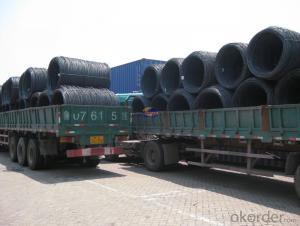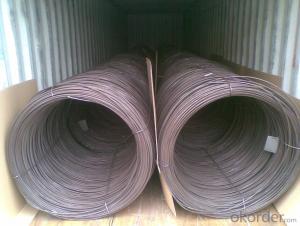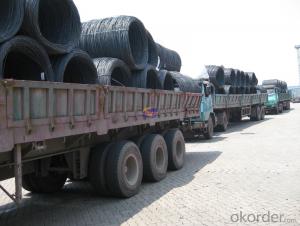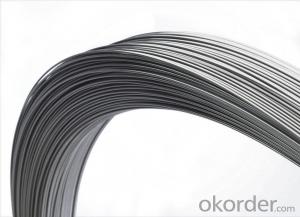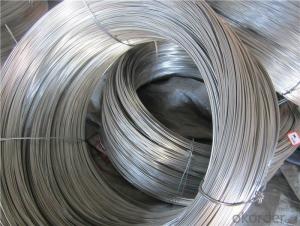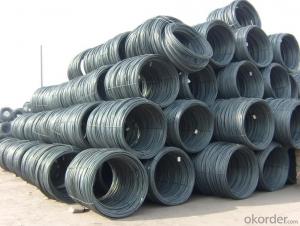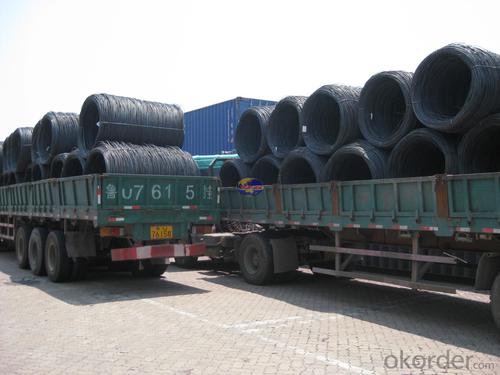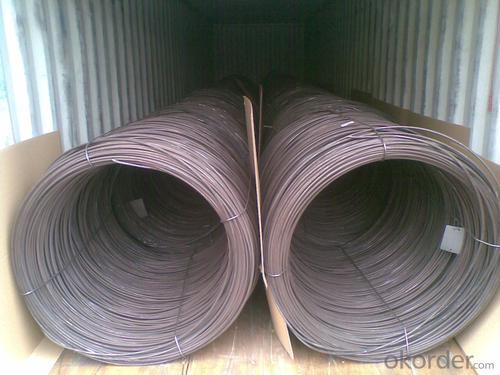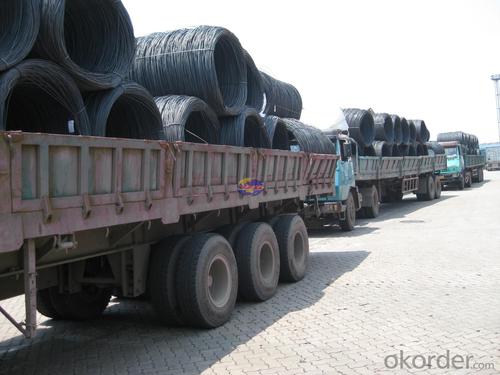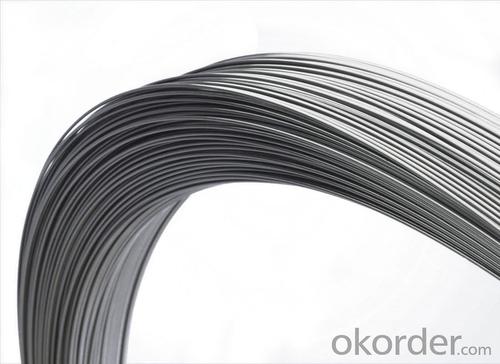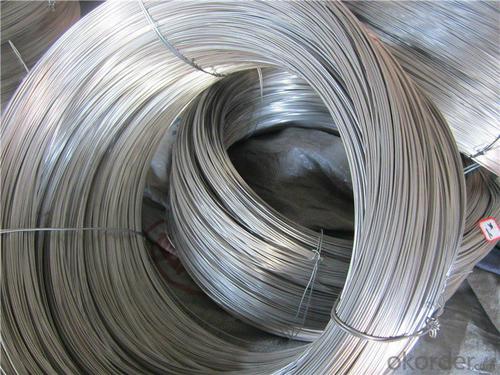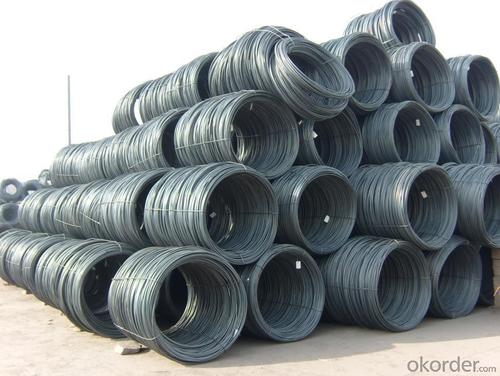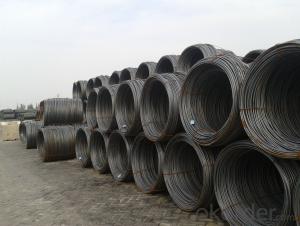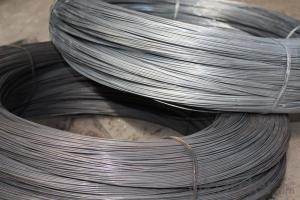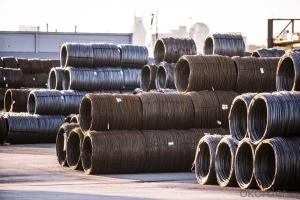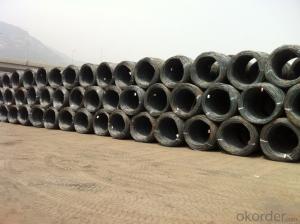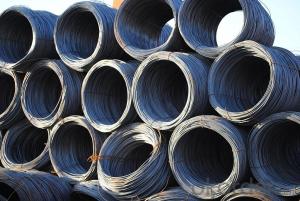SAE1006Cr Carbon Steel Wire Rod 15.5mm for Welding
- Loading Port:
- Shanghai
- Payment Terms:
- TT OR LC
- Min Order Qty:
- 100 m.t
- Supply Capability:
- 30000 m.t/month
OKorder Service Pledge
OKorder Financial Service
You Might Also Like
Specification
Description of SAE1006Cr Carbon Steel Wire Rod 15.5mm for Welding:
OKorder is offering Color Coated Steel Coil Prepainted Steel Coil at great prices with worldwide shipping. Our supplier is a world-class manufacturer of steel, with our products utilized the world over. OKorder annually supplies products to European, North American and Asian markets. We provide quotations within 24 hours of receiving an inquiry and guarantee competitive prices.
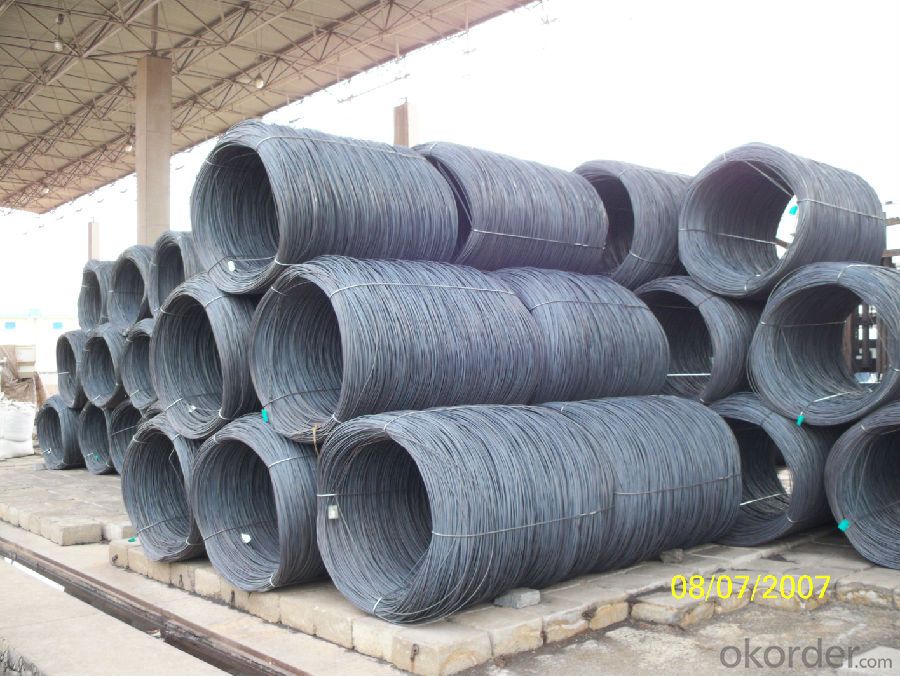
Applications of SAE1006Cr Carbon Steel Wire Rod 15.5mm for Welding:
Color Coated Steel Coil Prepainted Steel Coil are ideal for structural applications and are widely used in the construction of buildings and bridges, and the manufacturing, petrochemical, and transportation industries.
Main Product Features of SAE1006Cr Carbon Steel Wire Rod 15.5mm for Welding:
· Premium quality
· Prompt delivery & seaworthy packing (30 days after receiving deposit)
· Corrosion resistance
· Can be recycled and reused
· Mill test certification
· Professional Service
· Competitive pricing
Specifications of SAE1006Cr Carbon Steel Wire Rod 15.5mm for Welding:
1, Introduction: Color coated steel coils(sheets), i. E. PPGI, also called prepainted steel coils(sheets), are made of galvanized steel coils(sheets) with polymer coatings as surface. It's a new enclosure material and building board with characteristics of light-weighted, heat preserved&insulated, easily installed with bright colors.
2, Production Process: Pretreatment(Degreasing)_Drying_Chromating_Paint Basic Oil_Cooling_Drying_Color Coating_Cooling_Film-covering_Rolling Up
3, Characteristics:
Good at corrosion resistence. Besides zinc coating of the basic plate of galvanized steel sheet, the color coating as the surface has double lifetime to ensure better anticorrosion effect.
With excellent cold bending molded manufacturablity, PPGI products can be processed or directly used as final product. As being light-weighted and conveniently transported, they're widly used to replace wood to save energy.
4.There're thousands of colors can be chosen as per different application. Any color plays well in decoration.
No pollution with high recycling rate, PPGI coils and sheets are strongly recommended as enviroment-friendly products by the government.
5, eye bands and 4 circumferential bands in steel, galvanized metal fluted rings on inner and outer edges, galvanized.
| commodity | SAE1006Cr Carbon Steel Wire Rod 15.5mm for Welding |
| Techinical Standard: | JIS G3302-1998, EN10142/10137, ASTM A755 |
| grade | Q195,Q215,Q235,SAE1006,SAE1008 SAE1006Cr |
| Types: | Mesh welding |
| Base metal | galvanized, galvalume, cold rolled steel |
| Thickness | 0.14-1.0mm(0.16-0.8mm is the most advantage thickness) |
| Width | 610/724/820/914/1000/1200/1219/1220/1250mm |
| Type of coating: | PE, SMP, PVDF |
| Zinc coating | Z60-150g/m2 or AZ40-100g/m2 |
| Top painting: | 5 mic. Primer + 15 mc. R. M. P. |
| Back painting: | 5-7 mic. EP |
| Color: | According to RAL standard |
| ID coil | 508mm610mm |
| Coil weight: | 2--3MT |
| Package: | Properly packed for ocean freight exportation in 20'containers |
| Application: | Industrial panels, roofing and siding for painting/automobile |
| Price terms | FOB, CFR, CIF |
| Payment terms | 20%TT in advance+80% TT or irrevocable 80%L/C at sight |
| delivery time | 25 days after recepit of 20% TT |
| Remarks | Insurance is all risks |
| MTC 3.1 will be handed on with shipping documents | |
| We accept SGS certificatation test |
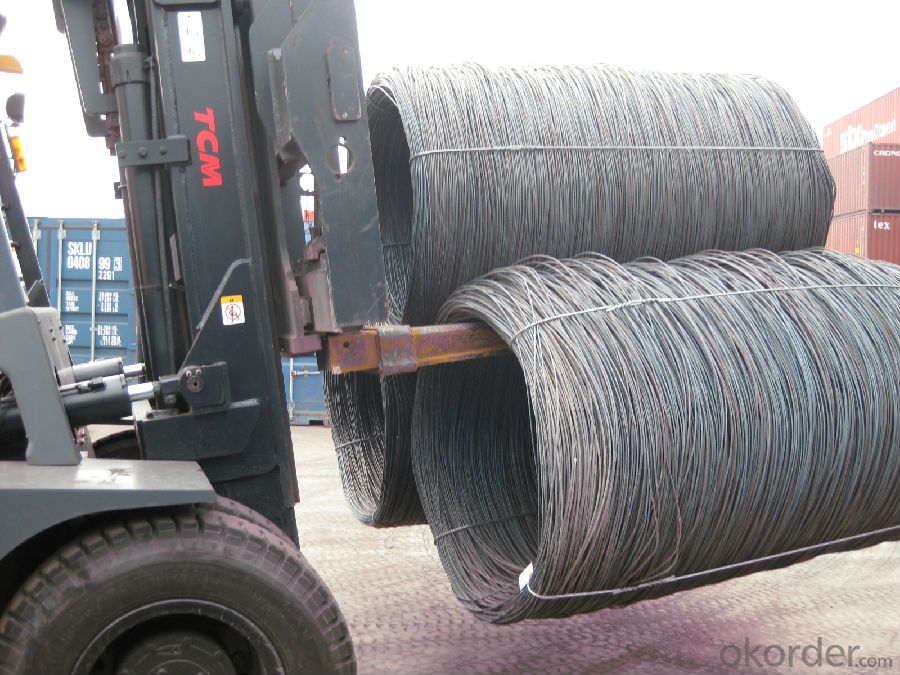
FAQ of SAE1006Cr Carbon Steel Wire Rod 15.5mm for Welding:
Q1: Why buy Materials & Equipment from OKorder.com?
A1: All products offered byOKorder.com are carefully selected from China's most reliable manufacturing enterprises. Through its ISO certifications, OKorder.com adheres to the highest standards and a commitment to supply chain safety and customer satisfaction.
Q2: How do we guarantee the quality of our products?
A2: We have established an advanced quality management system which conducts strict quality tests at every step, from raw materials to the final product. At the same time, we provide extensive follow-up service assurances as required.
Q3: How soon can we receive the product after purchase?
A3: Within three days of placing an order, we will begin production. The specific shipping date is dependent upon international and government factors, but is typically 7 to 10 workdays.
Q4: What makes stainless steel stainless?
A4: Stainless steel must contain at least 10.5 % chromium. It is this element that reacts with the oxygen in the air to form a complex chrome-oxide surface layer that is invisible but strong enough to prevent further oxygen from "staining" (rusting) the surface. Higher levels of chromium and the addition of other alloying elements such as nickel and molybdenum enhance this surface layer and improve the corrosion resistance of the stainless material.
Q5: Can stainless steel rust?
A5: Stainless does not "rust" as you think of regular steel rusting with a red oxide on the surface that flakes off. If you see red rust it is probably due to some iron particles that have contaminated the surface of the stainless steel and it is these iron particles that are rusting. Look at the source of the rusting and see if you can remove it from the surface.
- Q: What are the common production processes for boron-coated steel wire rod?
- The common production processes for boron-coated steel wire rod typically include wire drawing, boron coating, annealing, and final finishing.
- Q: What are the common impurities found in steel wire rod?
- The common impurities found in steel wire rod include sulfur, phosphorous, manganese, silicon, and traces of other elements such as copper and nickel.
- Q: How is steel wire rod used in the production of wire ropes for elevators?
- Steel wire rod is an essential element utilized in the manufacturing of wire ropes utilized in elevators. These wire ropes are carefully designed to ensure strength, durability, and safety. The steel wire rod acts as the primary material for the production of these ropes. Throughout the production procedure, the steel wire rod undergoes multiple stages in order to convert it into wire ropes for elevators. Initially, the rod is thoroughly cleaned and inspected to guarantee its quality. Subsequently, it is heated and passed through a sequence of dies to gradually decrease its diameter. This drawing process aids in enhancing the wire's strength and flexibility. Following the drawing process, the wire is subjected to galvanization to provide protection against corrosion. This involves applying a layer of zinc onto the wire, which effectively prevents rust and corrosion, thereby ensuring the longevity of the wire ropes. Once the wire has been galvanized, it is twisted and braided into strands. These strands are then combined and twisted together to form the final wire rope. The number of strands and the direction of the twist may vary according to the specific requirements of the elevator application. The resultant wire rope, derived from steel wire rod, possesses exceptional strength and flexibility, rendering it suitable for supporting heavy loads and enduring constant movement. It offers stability and safety, enabling elevators to operate reliably and efficiently. In conclusion, steel wire rod plays a crucial role in the production of wire ropes for elevators. Through various processes such as drawing and galvanization, the wire rod is transformed into robust and long-lasting wire ropes capable of withstanding the demanding conditions of elevator operations.
- Q: How are steel wire rods used in the production of welding electrodes?
- Steel wire rods are used in the production of welding electrodes as they serve as the core material for the electrode. The steel wire rods are manufactured with specific chemical composition and mechanical properties to ensure strength and durability. They are then further processed to form the electrode's outer coating, which provides additional properties such as arc stability, slag removal, and alloying elements. Overall, steel wire rods are essential for the production of welding electrodes as they form the backbone of the electrode, enabling efficient and effective welding operations.
- Q: What are the different surface marking materials used for steel wire rod?
- Steel wire rod can be marked using various surface marking materials to provide identification and traceability. Some commonly used materials include paint, ink, hot stamping, laser marking, and etching. 1. Paint is frequently used to mark steel wire rod and can display information like product identification, grade, and the manufacturer's logo. Paint markings are durable and can withstand handling and transportation. 2. Ink is another popular option for marking steel wire rod. It is applied through a printing process and can indicate product specifications, lot numbers, and barcodes. Ink markings are resistant to abrasion and offer high-contrast visibility. 3. Hot stamping involves applying a marking foil to the surface of the steel wire rod using heat and pressure. This technique transfers pre-printed information onto the rod, often including heat numbers, production dates, and customer-specific requirements. 4. Laser marking is a non-contact process that uses a laser beam to create permanent markings on the surface of the steel wire rod. This method allows for precise engraving of information like logos, serial numbers, and part numbers. Laser markings are highly durable and resistant to fading. 5. Etching is a chemical process that removes a thin layer of material from the surface of the steel wire rod. It creates indented markings that can be filled with paint or ink for increased visibility. Etched markings are resistant to abrasion and provide a long-lasting identification solution. The choice of surface marking material for steel wire rod depends on factors such as required durability, visibility, and specific application requirements. Each material offers its own advantages and can be customized to meet the needs of wire rod manufacturers and end-users.
- Q: How is the chemical composition of steel wire rod analyzed?
- The chemical composition of steel wire rod is typically analyzed using various techniques and methods. One common method is called spectroscopy, which involves the use of instruments such as atomic absorption spectroscopy (AAS) or inductively coupled plasma spectroscopy (ICP). These instruments can accurately determine the presence and concentration of different elements in the steel wire rod. Another technique commonly used is X-ray fluorescence (XRF), which works by bombarding the sample with X-rays and measuring the energy emitted by the elements present in the steel wire rod. This method provides quick and non-destructive analysis of the chemical composition. In addition to spectroscopy and XRF, other methods like optical emission spectroscopy (OES) and mass spectrometry can also be employed for analyzing the chemical composition of steel wire rod. These techniques involve the vaporization and ionization of the sample, followed by the measurement of the resulting ions or emitted photons. It is important to note that these techniques require the steel wire rod to be prepared as a sample, often in the form of a solid or liquid. The sample is usually dissolved, digested, or mixed with appropriate reagents to extract the elements of interest before analysis. Overall, the analysis of the chemical composition of steel wire rod is a crucial step in quality control and ensuring that the material meets the required specifications for its intended use.
- Q: How is steel wire rod tested for hardness?
- Steel wire rod is typically tested for hardness using a method called the Rockwell hardness test. In this test, a small indenter is pressed into the surface of the wire rod under a specified load. The depth of penetration is measured, and a hardness value is determined based on the depth of indentation. This test helps assess the wire rod's ability to resist deformation and indicates its suitability for various applications.
- Q: How does the dimensional accuracy of steel wire rod vary with different heat treatment processes?
- Different heat treatment processes can result in varying dimensional accuracy for steel wire rods. Heat treatment involves subjecting the wire rod to controlled heating and cooling procedures that alter its physical and mechanical properties. One commonly used heat treatment process for steel wire rods is annealing. Annealing involves heating the wire rod to a specific temperature and then gradually cooling it. This process helps alleviate internal stresses, enhance ductility, and refine the grain structure of the steel. In terms of dimensional accuracy, annealing can minimize internal stresses that may lead to distortion or warping in the wire rod, resulting in improved dimensional stability. Another heat treatment process is quenching and tempering. Quenching involves rapidly cooling the wire rod after heating it to a high temperature, typically using a liquid like oil or water. This rapid cooling hardens the steel, making it stronger but also more brittle. To enhance toughness and reduce brittleness, the wire rod is then tempered by reheating it to a lower temperature and slowly cooling it. The quenching process can affect dimensional accuracy due to the rapid cooling, which may cause distortion or warping. However, tempering helps decrease brittleness and minimize distortion, leading to improved dimensional accuracy. Additionally, other heat treatment processes such as normalizing and stress relieving can also impact the dimensional accuracy of steel wire rods. Normalizing involves heating the wire rod to a specific temperature and allowing it to cool in still air. This process refines the grain structure and improves the mechanical properties of the steel. On the other hand, stress relieving involves heating the wire rod to a temperature below the critical range and gradually cooling it, which reduces internal stresses. Both normalizing and stress relieving can contribute to improved dimensional accuracy by minimizing distortions or warping. To summarize, the dimensional accuracy of steel wire rods can vary depending on the heat treatment process used. Annealing, quenching and tempering, normalizing, and stress relieving are some commonly employed heat treatment processes that can affect dimensional accuracy. Careful consideration should be given to the choice of heat treatment process in order to achieve the desired dimensional accuracy while also meeting the required mechanical properties of the steel wire rod.
- Q: What are the different surface finishes available for processed steel wire rod?
- Processed steel wire rods can be finished in several ways, each with its own distinct characteristics and uses. Some commonly used surface finishes include: 1. Bright Finish: This is the most commonly employed and basic surface finish for steel wire rods. It is achieved through acid pickling and subsequent cold rolling, resulting in a smooth and shiny appearance. Bright finish wire rods are suitable for general applications where aesthetics and corrosion resistance are not major concerns. 2. Coated Finish: Steel wire rods can be coated with different materials to enhance their performance and functionality. Common coating materials include zinc (galvanized finish), copper, nickel, or a combination of these. Coated finishes offer improved corrosion resistance, increased durability, and enhanced electrical conductivity, making them suitable for specific applications such as fencing, electrical wiring, or automotive components. 3. Cold Drawn Finish: This surface finish is achieved by pulling the wire rod through a series of dies, reducing its diameter and increasing its tensile strength. Cold drawn wire rods have a polished and smooth appearance, making them ideal for applications requiring high strength and precision, such as automotive parts, springs, or fasteners. 4. Phosphated Finish: This surface finish involves coating the steel wire rod with a layer of phosphate to improve its corrosion resistance and enhance its lubrication capabilities. Phosphated wire rods are commonly used in applications where lubrication is necessary, such as the production of screws, bolts, or chains. 5. Galvannealed Finish: This surface finish combines the benefits of galvanizing and annealing processes. The steel wire rod is first coated with a layer of zinc and then heated to allow the zinc to alloy with the metal surface. Galvannealed wire rods exhibit excellent corrosion resistance and can be easily painted or welded. They are commonly utilized in the manufacturing of automotive parts, appliances, or construction materials. To sum up, the range of surface finishes available for processed steel wire rods offers a wide array of properties and applications. Whether it is for improved corrosion resistance, enhanced strength, or specialized functions, each finish provides unique advantages to cater to various industries and specific requirements.
- Q: How is steel wire rod used in the manufacturing of wire mesh partitions?
- Steel wire rod is used in the manufacturing of wire mesh partitions as it serves as the primary raw material. The wire rod undergoes various processes such as drawing, annealing, and galvanization to produce high-quality steel wires. These wires are then woven, welded, or interlocked to create the mesh pattern of the partitions. The strength and durability of the steel wire rod make it an ideal choice for ensuring the structural integrity and security of wire mesh partitions.
Send your message to us
SAE1006Cr Carbon Steel Wire Rod 15.5mm for Welding
- Loading Port:
- Shanghai
- Payment Terms:
- TT OR LC
- Min Order Qty:
- 100 m.t
- Supply Capability:
- 30000 m.t/month
OKorder Service Pledge
OKorder Financial Service
Similar products
Hot products
Hot Searches
Related keywords
